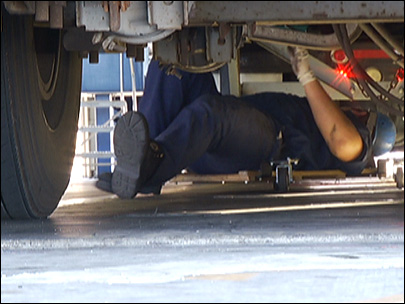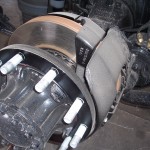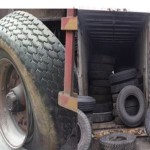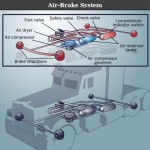
EXTERNAL PHYSICAL INSPECTION
Front sheet metal, paint and bumper – Inspect for appearance/accident.
Front lights and directional signals – Inspect.
Left front tyre – Inspect for cuts or unusual wear, torque wheel nuts.
Left-hand side of cab – Inspect for appearance and condition.
Left-side door hinges and latch – Lubricate, adjust if necessary.
Window regulators and vents – Test operation.
Fuel tank mountings – Tighten if required.
Battery – Examine box cover clamps; inspect level of each cell.
Left-side of body and frame – Inspect for appearance and condition.
Left-rear tyres – Examine for cuts or signs of unusual wear. Torque wheel and axle flange nuts.
Fifth-wheel mountings – Tighten if required.
Rear of vehicle – Inspect for appearance and condition.
Cab sheet metal – Inspect for appearance and condition.
Right rear tyres – Examine for cuts or signs of unusual wear. Torque wheel and axle flange nuts.
Right side of body and frame – Inspect for appearance and condition.
Right side door hinges and latch – Lubricate, adjust if necessary.
Window regulators and vents – test operation.
Right front tyre – Examine for cuts or unusual wear. Torque wheel nuts.
Front ball joints – Inspect on both wheels for excessive looseness.
Front kingpins and bearings – Inspect on both wheels for looseness.
Front brake linings, anchors, locks, wheel cylinders and drums – Inspect, blow out drums and shoes.
Lubricate shoe anchors and cams — wedge-type brakes, clean and lubricate actuating components.
Front wheel bearings – Clean, repack and adjust for both front wheels. Replace grease retainer.
Rear brake linings, anchors, locks, wheel cylinders and drums – Inspect. Blow out drums and shoes, lubricate shoe anchors and cams.
Wedge-type brakes – clean and lubricate actuating components. Adjust as required.
Wedge-type brake systems – Remove brake drums, clean and lubricate adjusting components.
Rear wheel bearings – Clean, repack and adjust. Replace grease retainer.
Front wheel caster and camber – Inspect to see that it is within specifications.
Toe-in — Adjust as required.
UNDER VEHICLE
Chassis – Lubricate according to correct lubricating chart.
Front tyres – Examine for cuts or unusual wear.
Front springs – Inspect for shackle looseness and wear. Inspect leaves for breakage and misalignment.
Pitman and steering arms, drag link and tie rod – Inspect.
Power steering cylinder – Inspect for leaks.
Propeller shaft – Inspect, including all brackets, flanges, hangers and center bearings.
Rear springs – Inspect for loose or worn shackles, broken or misaligned leaves.
Engine oil – Replace oil, filter element and gasket at change period.
Engine pan gasket, front and rear crankshaft seals – Inspect.
Engine mounts – Inspect for deterioration or looseness.
Clutch controls – Examine for any abnormal condition. Inspect clearance and adjustment.
Front U-bolts – Tighten to specifications.
Transmission – Inspect for leaks. Inspect the lubricant level. Add if necessary.
Automatic transmission cooler lines – Inspect for leakage.
Automatic transmission linkage – Adjust.
Transmission support and strut rod – Adjust if required.
Driveline-type parking brake – Inspect lining condition and adjust.
Auxiliary or transfer case – Inspect for leaks. See that breathers are not restricted. Tighten rear bearing retainer bolts.
Transmission; auxiliary or transfer case linkage pivot points – Lubricate.
Center bearing, brackets, U-joints and flanges – Tighten as required.
Rear axle – Inspect lubricant level, add if required. Clean breather.
Rear axle differential housing – Inspect for lubricant leakage and pinion bearings for looseness. See that axle breather is free of dirt.
Rear tyres – Examine for cuts and unusual wear.
Rear axle carrier housing and pinion cage bolts – Tighten.
Rear U-bolts – Tighten to specifications.
Air brake valve clevis pin – Lubricate.
Brake hoses, lines, valves, chambers, etc. – Inspect for leaks. Examine cross shaft, cables, linkage for abnormal wear.
Air tanks – Drain.
Frames and cross-members – Examine.
Exhaust pipe, muffler, tailpipe and hanger brackets – Inspect.
Cab hold-down-bolt insulators – Inspect, tighten bolts if required.
Body mounts – Tighten if required.
CAB/DRIVER ITEMS
Cab interior – Inspect for appearance and condition.
Seat adjustment – Operate. Inspect seat cushions.
Window regulators and wing vents – Operate.
Mirrors – Inspect for cracks, discoloration and tightness.
All lights, horn, tell-tale lights and dash instruments – Test.
Wipers – Inspect for correct operation and wear. Adjust, repair or replace as necessary.
Washers – Operate.
Radio; heater and directional signals – Operate.
Steering wheel – Inspect steering gear play.
Service brake pedal – Test for action and adequate reserve.
Parking brake – Test for action and adequate reserve.
Transmission lever – Shift through all gear positions.
Clutch pedal – Test for action and adequate free play.
Fire extinguisher – Inspect for leakage and secure mounting.
Fire extinguisher – Refill or recharge if needed.
Tools – See that those regularly assigned are in the vehicle.
Engine emergency stop – Test with engine off.
Throttle and accelerator controls – Test for binding.
Choke – Test for binding.
Seat belts – Securely anchored and in good condition.
Perhaps there are some details that we have inadvertently omitted in this post, kindly let us know in your comments. Thanks for taking the time.






